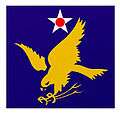25th Air Support Operations Squadron
The United States Air Force's 25th Air Support Operations Squadron is a combat support unit located at Wheeler Army Airfield, Hawaii. The squadron provides tactical command and control of airpower assets to the Joint Forces Air Component Commander and Joint Forces Land Component Commander for combat operations.[1]
25th Air Support Operations Squadron
 | |
|---|---|
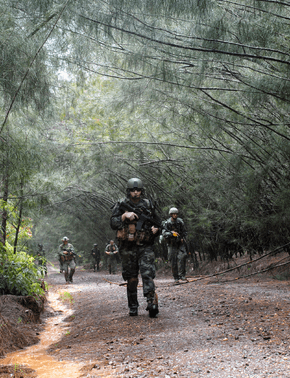 Tactical Air Control Party airmen of the 25th Air Support Operations Squadron at Wheeler Army Airfield's East Range | |
| Active | 1942–1949; 1971–1989; 1990–present |
| Country | |
| Branch | |
| Role | Air Operation Support |
| Engagements | South West Pacific Theater of World War II |
| Decorations | Distinguished Unit Citation Philippine Republic Presidential Unit Citation |
| Insignia | |
| 25th Air Support Operations Squadron emblem (approved 18 January 1943)[1] | |
History
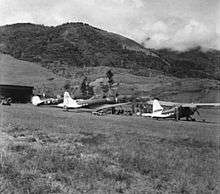
World War II and post-war era
The squadron was first activated at Salinas Army Air Base, California in March 1942 as the 25th Observation Squadron.[1] The squadron's cadre came from the 110th Observation Squadron, a federalized unit of the Missouri National Guard.[1][2] Initially, the primary aircraft of the squadron was the North American O-47, although it flew a number of other aircraft as well.[1] In April 1943 it was redesignated the 25th Liaison Squadron and converted to light two-seater aircraft. primarily Piper L-4s, but also including Stinson L-5 Sentinel. The unit moved overseas in October 1943 aboard the Cape Mendocino to Australia in the South West Pacific Theater.[2]
After pausing briefly in Australia, the squadron moved to New Guinea.[1] There it operated primarily with L-5 Sentinels, flown by enlisted pilots. Some of these "sergeant pilots" were men who had washed out of pilot school, but had been given a chance to operate the light aircraft.[3] Beginning in February 1944, the 25th began participating in combat operations.[1]
In addition to their mission of spotting and aerial reconnaissance, the squadron was tasked with short haul transportation.[2] The capability of its light aircraft to operate from confined spaces earned A Flight of the squadron the nickname "Guinea Short Lines".[4] The flight moved forward to Saidor Airport.[3]
The squadron dropped supplies to units caught behind enemy lines and evacuated them, sometimes dropping tools so that these units could hack a landing zone out of the jungle.[5] In addition to the task of evacuating downed aircrew members, the flight flew night harassment missions behind enemy lines, dropping small bombs and other paraphernalia on enemy camps. The flight was called on in 1944 to rescue a downed Republic P-47 Thunderbolt pilot from behind enemy lines. In the course of this operation, and while the downed pilot was clearing an area for an L-5 to land in the jungle, the squadron was tasked to also evacuate 23 Indian soldiers, who had escaped from a Japanese prisoner of war camp and who had intelligence information concerning Japanese troop positions. Flying into the improvised jungle airstrip, the flight successfully returned all to friendly control.[3]
Shortly after this rescue operation, the flight was tasked with transporting fifty Australian commandos to Wantoat to attack a Japanese radio facility. Following the raid, four Japanese prisoners were returned, each sitting on the lap of an Australian in the back seat of one of the Sentinels.[3]
By the end of 1944, the 25th began operating in the Philippines, earning two Distinguished Unit Citations and a Philippine Republic Presidential Unit Citation for its actions there.[1] During the Philippine campaign, the squadron also trained pilots of the liaison squadrons of the 3d Air Commando Group, which had just arrived in the theater.[3] It remained in the Philippines until August 1947, although it was not manned or equipped after January. Although it moved on paper to Kadena Air Base, Okinawa in August, it was not again manned until October 1947. It remained with the occupation forces on Okinawa until being inactivated in March 1949.[1]
Modern era
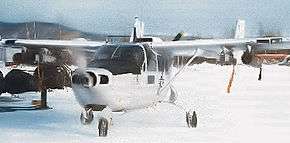
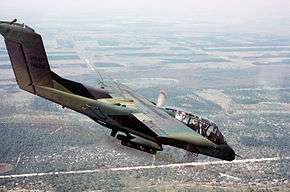
The squadron was again activated in July 1971 at Eielson Air Force Base, Alaska, as the 25th Tactical Air Support Squadron and equipped with the Cessna O-2 Skymaster.[6][7] In 1986 the 25th upgraded to the North American OV-10 Bronco, 1986–1989.[6] The squadron was inactivated in September 1989.[7]
Its most current period of active service in Hawaii began a little more than a year later in 1990, when it was activated as the 25th Air Liaison Squadron at Schofield Barracks. Three months later the squadron moved to Wheeler Army Airfield.[7] The unit has deployed in support of Air Force and Army missions.[8] The squadron is manned by tactical air controllers, a unique type of servicemembers—Air Force by service, but Army by trade, planning, communicating and facilitating the execution of close- air support for ground forces. To assist in their communication needs, the JTACs operate and maintain a complete array of equipment. Tactical Air Control is also one of the few jobs in the Air Force operates far forward on the battlefield.[9]
The 25th deployed to Afghanistan in 2006. They were located everywhere from headquarters to operations with company-sized elements, acting as the liaison for all air support that comes from all services and coalition partners. Their mission of calling in air support requires communication and planning. Planning includes advising leaders on the best ways to use air assets and coordinate so that close air support can operate safely on the battlefield with other indirect-fire assets, such as artillery and mortars.[9]
Lineage
- Constituted as the 25th Observation Squadron (Light) on 5 February 1942
- Activated on 2 March 1942
- Redesignated 25th Observation Squadron on 4 July 1942
- Redesignated 25th Liaison Squadron on 2 April 1943
- Inactivated on 25 March 1949[10]
- Redesignated 25th Tactical Air Support Squadron on 30 March 1971
- Activated on 8 July 1971
- Inactivated on 15 September 1989
- Redesignated 25th Air Liaison Squadron on 26 September 1990
- Activated on 1 October 1990
- Redesignated 25th Air Support Operations Squadron on 1 August 1994[7]
Assignments
- 71st Observation Group (later 71st Reconnaissance Group): 2 March 1942
- II Air Support Command (later II Tactical Air Division): 11 August 1943 (attached to 71st Reconnaissance Group)
- Fifth Air Force: 19 November 1943 (attached to 71st Reconnaissance Group)
- V Bomber Command: 24 November 1943 (attached to 71st Reconnaissance Group) (further attached to 5212th Photographic Wing (Provisional) after 13 December 1943)
- 91st Photographic Wing: 15 April 1944 (attached to 71st Reconnaissance Group)
- Far East Air Forces: 15 February 1945 (attached to Thirteenth Air Force)
- Thirteenth Air Force: 17 March 1945
- 403d Troop Carrier Group: 1 November 1945
- Thirteenth Air Force: 31 December 1945
- 85th Fighter Wing: 5 July 1946
- 1st Air Division: 30 March 1947
- Thirteenth Air Force: 15 September 1947
- Far East Air Forces: 1 December 1948 – 25 March 1949 (attached to 18th Fighter Wing)[10]
- 5010 Combat Support Group: 8 July 1971
- 343d Composite Wing: (later 343d Tactical Fighter Wing): 1 October 1981 – 15 September 1989
- 15th Air Base Wing: 1 October 1990
- 6010th Aerospace Defense Group: 24 May 1991
- 15th Operations Group: 13 April 1992
- 1st Air Support Operations Group: 1 October 2008 – present[7]
Stations
- Salinas Army Air Base, California, 2 March 1942
- Esler Field, Louisiana, 26 January 1943
- Laurel Army Air Field, Mississippi, 31 March 1943 – 20 October 1943
- Brisbane, Australia, 24 November 1943
- Lae Airfield, New Guinea, 11 February 1944
- Nadzab Airfield Complex, New Guinea, 16 February 1944
- Biak, New Guinea, 7 September 1944
- Camp Dulag, Leyte, Philippines, c. 5 March 1945
- Malabang, Mindanao, Philippines, 19 April 1945
- Del Monte Airfield, Mindanao, Philippines, 2 June 1945
- Dulag, Leyte, Philippines, 17 November 1945
- Clark Field, Luzon, Philippines, c. 10 January 1946
- Kadena Air Base, Okinawa, 22 August 1947
- Clark Field, Luzon, Philippines, 8 September 1947 – 25 March 1949[10]
- Eielson Air Force Base, Alaska, 8 July 1971 – 15 September 1989
- Schofield Barracks, Hawaii, 1 October 1990
- Wheeler Army Airfield, 1 January 1991 – present[7]
Aircraft
- North American O-47, 1942–1943
- Stinson L-1 Vigilant, 1942–1943
- Taylorcraft L-2, 1942–1943
- Bell P-39 Airacobra, 1942–1943
- Curtiss P-40 Warhawk, 1942–1943
- North American B-25 Mitchell, 1942–1943
- Stinson L-5 Sentinel, 1943–1947, 1947–1948, probably 1948–1949
- Piper L-4, 1944–
- Fairchild UC-61 Forwarder, 1944
- Cessna UC-78 Bobcat, 1944–1945
- Douglas C-47 Skytrain, 1945–1946[10]
- Cessna O-2 Skymaster, 1979–1986[6]
- North American OV-10 Bronco, 1986–1989[6]
Awards and campaigns
| Award streamer | Award | Dates | Notes |
|---|---|---|---|
| Distinguished Unit Citation | Philippine Islands 10 December 1944 – 25 December 1944 | 25th Liaison Squadron[1] | |
| Distinguished Unit Citation | Philippine Islands 17 April 1945 – 1 June 1945 | 25th Liaison Squadron[1] | |
| Air Force Outstanding Unit Award | 1 January 1973-31 December 1974 | 25th Tactical Air Support Squadron[7] | |
| Air Force Outstanding Unit Award | 1 January-31 December 1975 | 25th Tactical Air Support Squadron[7] | |
| Air Force Outstanding Unit Award | 1 January-31 December 1976 | 25th Tactical Air Support Squadron[7] | |
| Air Force Outstanding Unit Award | 1 January 1977-31 December 1978 | 25th Tactical Air Support Squadron[7] | |
| Air Force Outstanding Unit Award | 1 January-31 December 1979 | 25th Tactical Air Support Squadron[7] | |
| Air Force Outstanding Unit Award | 1 January 1980-30 September 1981 | 25th Tactical Air Support Squadron[7] | |
| Air Force Outstanding Unit Award | 1 January 1983-30 June 1984 | 25th Tactical Air Support Squadron[7] | |
| Air Force Outstanding Unit Award | 1 July 1985-30 June 1987 | 25th Tactical Air Support Squadron[7] | |
| Air Force Outstanding Unit Award | 1 January 1988–(15 September) 1989 | 25th Tactical Air Support Squadron[7] | |
| Air Force Outstanding Unit Award | 1 July 1991-30 June 1993 | 25th Air Liaison Squadron[7] | |
| Air Force Outstanding Unit Award | 1 August 1994-30 September 1995 | 25th Air Liaison Squadron (later 25th Air Support Operations Squadron)[7] | |
| Air Force Outstanding Unit Award | 1 October 1995-1 August 1997 | 25th Air Support Operations Squadron[7] | |
| Air Force Outstanding Unit Award | 2 August 1997-1 August 1999 | 25th Air Support Operations Squadron[7] | |
| Air Force Outstanding Unit Award | 29 November 1999-30 November 2001 | 25th Air Support Operations Squadron[7] | |
| Air Force Outstanding Unit Award | 1 November 2002–31 October 2004 | 25th Air Support Operations Squadron[7] | |
| Air Force Outstanding Unit Award | 1 November 2004–31 October 2006 | 25th Air Support Operations Squadron[7] | |
| Air Force Outstanding Unit Award | 1 November 2006–31 October 2007 | 25th Air Support Operations Squadron[7] | |
| Air Force Outstanding Unit Award | 1 November 2008–31 October 2010 | 25th Air Support Operations Squadron[7] | |
| Philippine Republic Presidential Unit Citation | 10 December 1944-4 July 1945 | 25th Liaison Squadron[1] |
| Campaign Streamer | Campaign | Dates | Notes |
|---|---|---|---|
| Antisubmarine | 27 May 1942 – 20 August 1942 | 25th Observation Squadron[1] | |
| New Guinea | 11 February 1944 – 31 December 1944 | 25th Liaison Squadron[1] | |
| Leyte | 10 December 1944 – 1 July 1945 | 25th Liaison Squadron[1] | |
| Luzon | 5 March 1945 – 4 July 1945 | 25th Liaison Squadron[1] | |
| Southern Philippines | 5 March 1945 – 4 July 1945 | 25th Liaison Squadron[1] | |
| Iraqi Governance | 29 June 2004 – 15 December 2005 | 25th Air Support Operations Squadron[7] | |
| National Resolution | 16 December 2005 – 9 January 2007 | 25th Air Support Operations Squadron[7] | |
| Iraqi Surge | 10 January 2007 – 31 December 2008 | 25th Air Support Operations Squadron[7] |
See also
References
Notes
- Maurer, Combat Squadrons, p. 131
- Cannon & Stratton, p. 18
- Oliver
- "Guinea Short Lines IHRA". International Historical Research Associates. Retrieved 20 August 2014.
- Cannon & Straton, p. 20
- "Eielson Air Force Base History: Aircraft Operating". Explore North. Retrieved 20 August 2014.
- Dollman, TSG David (15 May 2017). "25 Air Support Operations Squadron (PACAF)". Air Force Historical Research Agency. Retrieved 2 April 2018.
- Cuomo, TSG Shane A. (17 April 2006). "25th Air Support Operations Squadron prepares to deploy". Air Force Pacific News. Retrieved 20 August 2014.
- Magni, SGT Frank (22 November 2004). "Tactical Controllers Command Over Afghan Sky". Department of Defense News. Retrieved 20 August 2014.
- Lineage prior to 1963, including assignments, stations, and aircraft in Maurer, Combat Squadrons, p. 131
Bibliography
![]()
- Maurer, Maurer, ed. (1982) [1969]. Combat Squadrons of the Air Force, World War II (PDF) (reprint ed.). Washington, DC: Office of Air Force History. ISBN 0-405-12194-6. LCCN 70605402. OCLC 72556.
- Oliver, David (2005). Airborne Espionage: International Special Duty Operations in the World Wars. England: The History Press. ISBN 978-0750938709.
- Cannon, Hardy; Stratton, Bill (2007). Box Seat Over Hell: The True Story of America's Liaison Pilots and their Light Planes in World War II (2nd ed.). San Antonio, TX: Alamo Liaison Squadron. ISBN 978-0615178974.

.jpg)
.svg.png)
.svg.png)
